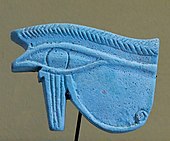Eye idol
Eye idols play a role in some prehistoric archaeological cultures of the Old and New World. They had the character of amulets and were supposed to ward off evil (as an apotropaic spell). Indications of the face on ceramics are geographically and chronologically widespread (Hotnica near Veliko Tȃrnovo, Bulgaria). Ceramics with eye representations were found in or on stone age barrows in northern Europe. Two eyes with accentuated eyebrows and possibly the nose form the decoration. In Denmark, the pots with the decorations found in Måneshøj belong to the so-called Bundsø style, which dates from around 3000 BC. Appeared. The custom reached its peak around 3300-3200 BC. And then stopped. The motif can be found in other parts of Europe with ( Iberian Peninsula ) or without connection with megalithic systems .
Egypt
In ancient Egypt , the udjat eye of the god Horus , a hieroglyph , was said to have healing powers. The Horus eye is the left eye ("moon eye") of Horus healed by Thoth . As an amulet, it served as protection against the “ evil eye ”, and it should also bring strength and fertility. In the New Kingdom the coffins were decorated with it ("magic eyes").
Mesopotamia
In Iraq, in the temple of the eyes of Tell Brak (from the Jemdet-Nasr period around 2800 BC), flat, highly abstract black and white figurines made of alabaster were found , with the body mostly only made of a plate and the face only out of the eyes indicated brows and forehead lines. In one case two children were carved into the body plate in relief, another idol has two heads on top of each other. Sometimes two or three figures are united with one another. Most have one pair of eyes, but there are some with two. Some wear crowns, some are clearly identified as deities. Terracotta eye idols have been found in Ur , Mari and Lagasch . Since their eyes have the shape of open loops, they are called glasses idols. Some of these idols date from the late Uruk period (3300-3000 BC) and are mainly found in northern Mesopotamia and Syria. They were initially viewed as votive offerings, but were used in the spinning mill.
Spain
In Los Millares , Spain , a site from the 3rd millennium BC. BC, there were stylized idols made of stone, bone or baked clay (terracotta), the representation of which is reduced to large round eyes (owl eyes). The ceramics from Los Millares, which are known as symbolic ceramics because of their decoration, also have so-called oculus motifs (representations of the eyes).
Greece, Turkey, Cyprus
Eye representations on Greek ceramics could be traced back to the fact that the ceramics were anthropomorphized (humanized).
Not much younger are flat alabaster idols from Kültepe (around 1950–1800 BC), in which up to three necks grow out of a body disc, bearing highly schematic heads with faces practically only consisting of the eyes. Children are depicted on the body disk. In addition, the bodies wear rings with a point in the center. The eyes are shown in the same way.
From Cyprus date from around 2000–1900 BC. The so-called board idols . They are made of terracotta and also appear as twin idols. Here, too, the design of the faces is limited to the reproduction or suggestion of a few features (including large eyes made of concentric circles).
America
Typical of the Mississippi culture are human head and face depictions that show watering eyes or eyes surrounded by fork or wing-like motifs (face painting, tattoos). Such representations can achieve a high degree of abstraction. Motifs called weeping eyes, forked or winged eyes can even become independent. These eye idols are interpreted as rain symbols.
literature
- Glyn Daniel : Encyclopedia of Archeology . Lübbe, 1980, ISBN 3-930656-37-X .




